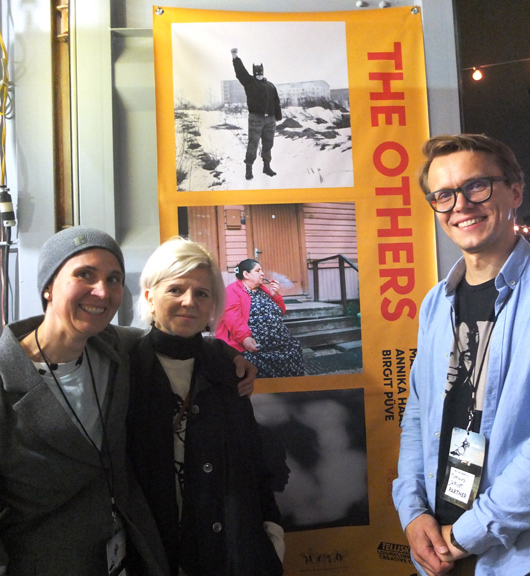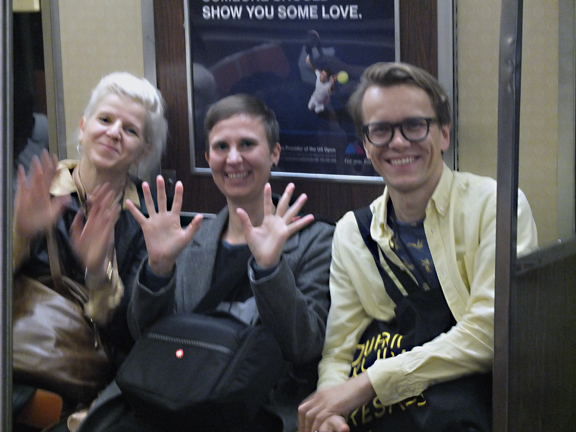h. nazan ışık—
24 September 2018—
There were so many great photograps, exhibits to see at Photoville. But the projects name “The Others”, presented by ‘Juhan Kuus Documentary Center’ (JKDPC), and very warm smile offered by Toomas Järvet , co-founder of JKDPC and curator; caught my attantion, and made me stop.
h. nazan ışık: Why are you here, in Photoville?
Toomas Järvet: We are here in Photoville to present our project called the “Others”. WE have three photographers with tree different works
Maxim Mjödov, born in Tallinn, Estonia, takes us to the eastern part of capital Tallinn, widely considered as the major residential area for the major Other — the Russian-speaking population who mostly arrived to Estonia from all over the Soviet Union during the USSR era from the late 1940s to late 1980s.
Birgit Püve examines a small settlement of Vao in the eastern part of Estonia and it’s current inhabitants, and her work focuses on memory and identity.
The third photographer of this joint exhibition, Annika Haas documented the most mysterious minority of the Others in Estonia — the Romas or Gypsies as they are called by locals.

(L-R) Annika Haas, with her project “We, The Roma” , one of the three photographers featured in “The Others” exhibition, presented by Juhan Kuus Documentary Photography Center (JKDPC)); Kristel Laur, co-founder/the head of JKDPC) and curator; Toomas Järvet, co-founder of and curator; in front of the poster of their exhibit “The Other” at Photoville in NY (h. nazan ışık /NKENdiKEN)
HNI: Why did you name your project “The Others”?
TJ: We named it “The Others”, because we wanted to show a kind of a different layer of Estonia. Estonia is one of the smallest countries in Europe, and it is home to about 1,3 million people. We are small, but we have many different communities and smaller cultures within our society that nobody really knows about it. And, it is because mostly Estonia has been pictured in foreign press and medias kind of Nordic Wonderland. Beautiful nature, lakes, beautiful blonde haired people with blue eyed. We wanted to show the different side.
HNI: What or who are the main ‘Others’?
TJ: The main ‘Others’ by population..
HNI: (I interrupted ) But couldn’t everyone be the ‘Other’ or ‘Others’ for anyone?
TJ: This is a very conceptual question. But the idea of the ‘Others’, they are ‘Others’ until we know them. When we get to know the ‘Others’ we can then call them ‘one of us’. But the problem now in Estonia is that many different communities, and we don’t get to know them.
HNI: We call them ‘one of us’ you said. Who is ‘Us’?
TJ: Well, typically ‘Us’ is that of our own culture, or our own families, oh we are ‘Us’, we are one family like we have something in common. But also, we want to help with our project to get closer to so called the ‘Others’ to Estonians.
HNI: Why did you name the documentary photography center ‘Juhan Kuus Documentary Center’ (JKDPC) ?
TJ: Because we started working with documentary project, and we discovered Juhan Kuus and his work for Estonia. Nobody knew about him. He was a South African-Estonian photographer, living in South Africa, documenting the lives and struggle of South African people during the apartheid.
When he died in 2015, we held his first exhibition ever in Estonia, and published his first book. But unfortunately, he couldn’t see his book published. And from there on, we started working in documentary photography more, and established the center in his name.
He had a dream he expressed us that maybe his book will inspire Estonian photographers to do more documentary photography.
HNI: What do you expect, what do you hope to get from Photoville?
TJ: We expect a lot of contacts, a lot of visitors. So far so good, we met with very interesting people, and we hope to meet more. And after this exhibition, we hope to collaborate, to exhibit Estonian photographer’s work abroad, and also, to show US photographers’ work in Estonia.
HNI: Annika, when did you start your “We, the Romas” project?
Annika Haas: I started my project actually 10 years ago, but what you see here is the product of seven years work.
HNI: Why did you get interested in Romas?
AH: When I was a young child my grandparent said, “Don’t stay out, Romans will kidnap you,” and I had some kind of fear towards that nationality. When I grow up I wanted to investigate that fear. And, now I am a great fan of this community.
HNI: How did you get an access to document them?
AH: They opened their homes to me.
HNI: What did you learn from them?
AH: That every nation could have bad and good guys. It doesn’t matter who you are, your nationality, your sexuality, your color. We are all humans.
I think that is a great lesson that we all should learn and remember.

(L-R) Kristel Laur, curator; Annika Haas, photographer; Toomas Järvet , curator; from Photoville container exhibitions “the Others”, saying ‘Goodby” from a train . (h. nazan ışık/ NKENdiKEN)
I like this picture to close Photoville. We were on the same platform waiting for different trains. Their train came first, they got on, and mine was approaching the platform. I turned around; their car door was about to close. We had just enough time to say ‘Good Bye’.
Photos:© h. nazan ışık /NKENdiKEN
© h. nazan ışık
